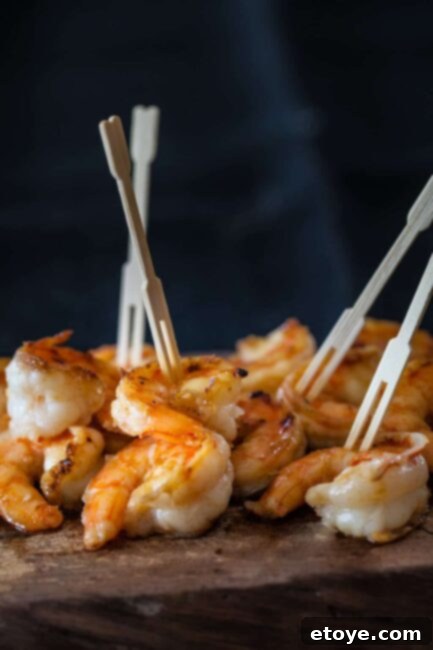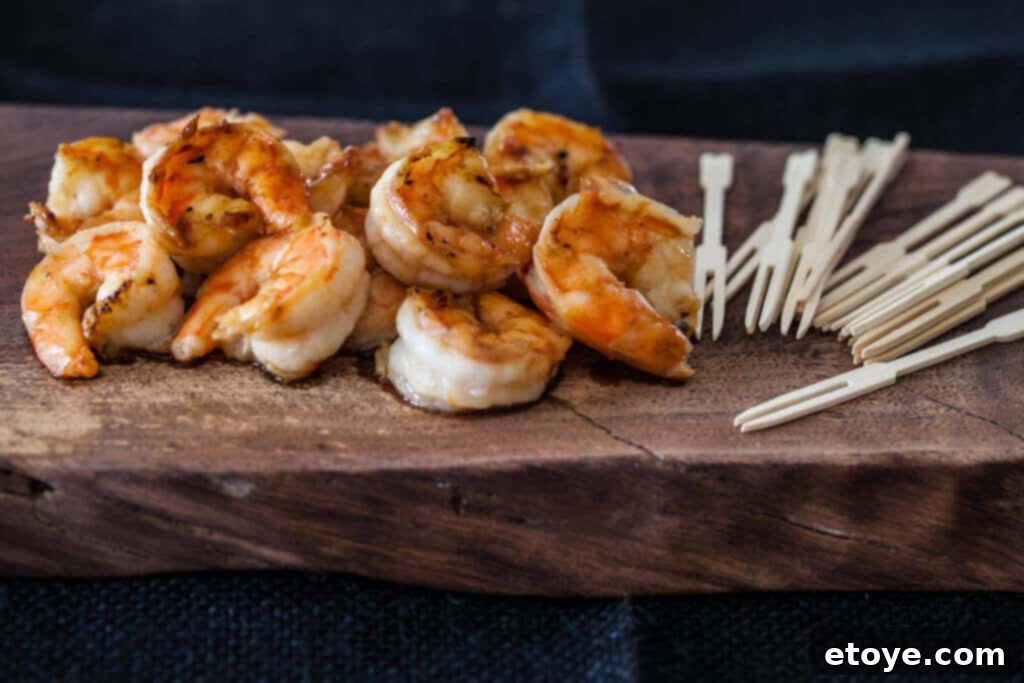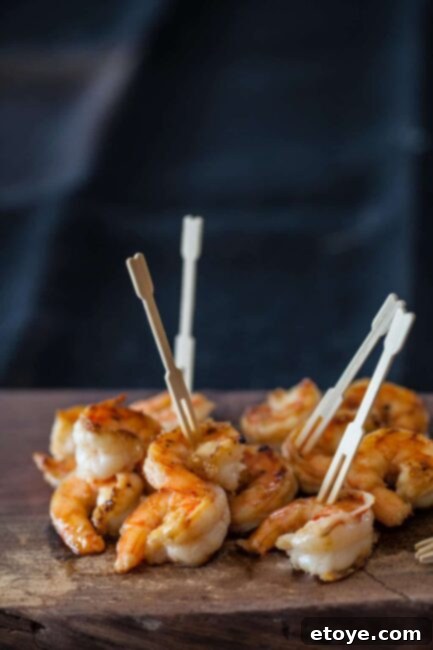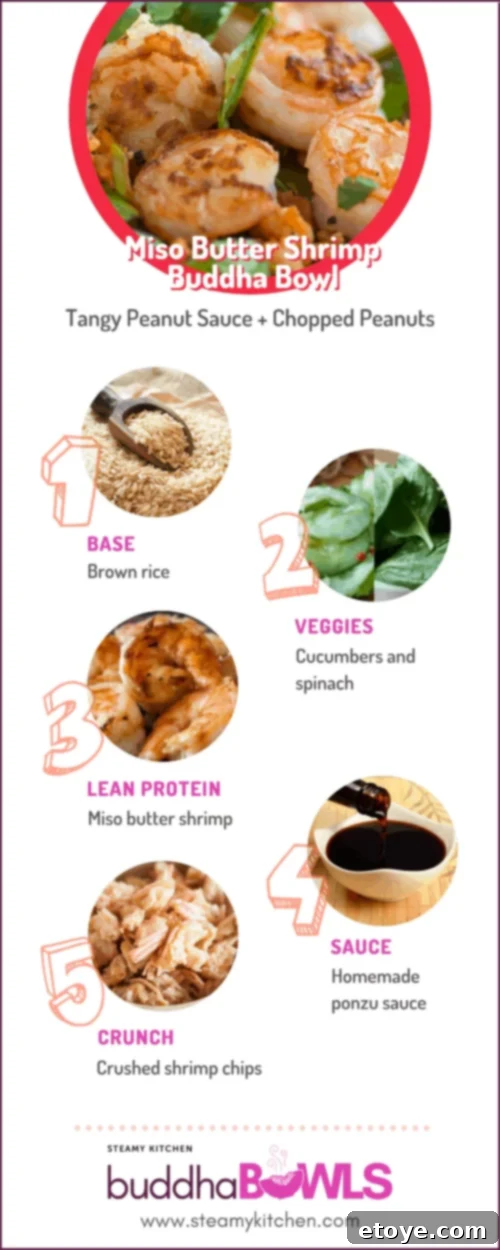Welcome to the ultimate guide for creating the most exquisite Miso Butter Shrimp! This incredibly simple yet profoundly flavorful dish brings the vibrant tastes of Japan right to your kitchen, proving that gourmet flavors don’t require hours of effort. Imagine succulent shrimp, perfectly infused with a rich, savory, and slightly sweet miso butter glaze. This isn’t just a recipe; it’s a culinary journey designed for convenience and deliciousness, ready in just 15 minutes with only a handful of staple ingredients. Whether you’re seeking a quick weeknight dinner, an impressive appetizer, or a versatile protein to elevate your favorite sides, Miso Butter Shrimp delivers on all fronts. Get ready to transform your mealtime with this irresistible seafood sensation that promises ease without compromising on an authentic, deeply satisfying Japanese flavor experience.

Why You’ll Absolutely Love This Miso Butter Shrimp Recipe
This Miso Butter Shrimp isn’t just another dish; it’s a culinary revelation that will quickly become a cherished favorite in your repertoire. Here’s what makes it truly exceptional:
- A Symphony of Japanese Flavors: This recipe masterfully blends the rich, umami depth of miso with the subtle sweetness of mirin and the crispness of sake, all rounded out by the luxurious texture of butter and a kick of fresh ginger. The result is a complex yet harmonious flavor profile that is both comforting and exotic, capturing the essence of Japanese culinary tradition.
- Lightning-Fast Preparation: In today’s fast-paced world, time is precious. This dish is your ally, requiring only about 15 minutes from start to finish. A quick marinade and an even quicker cook time mean you can have a gourmet meal on the table in less time than it takes to order takeout. It’s the perfect solution for busy weeknights or unexpected guests.
- Minimal Ingredients, Maximum Impact: You’ll be amazed at the depth of flavor achieved with just five core ingredients (plus the shrimp!). This simplicity means less shopping, less prep, and less cleanup, making it an ideal choice for both novice cooks and seasoned chefs looking for efficiency. Quality ingredients truly shine through in this elegant dish.
- Incredibly Versatile for Any Occasion: The adaptability of Miso Butter Shrimp is one of its greatest strengths. Serve it as an elegant appetizer with toothpicks, a protein-packed main course over fluffy white rice, quinoa, or noodles, or even incorporate it into salads and wraps for a refreshing twist. Its deliciousness transcends meal types, fitting perfectly into casual dinners or sophisticated gatherings.
- Easily Adaptable to Dietary Needs: For those following a gluten-free diet, this recipe is easily adaptable. Simply ensure your miso paste and sake are certified gluten-free (most are, but always check labels). Furthermore, shrimp is naturally low in calories and an excellent source of lean protein, making this a fantastic option for a healthy and satisfying meal.
- Nutrient-Rich and Wholesome: Beyond being delicious, shrimp offers a host of nutritional benefits. It’s packed with protein, essential vitamins like B12, and minerals such as selenium and iron, all while being remarkably low in fat. Paired with the gut-friendly probiotics in miso, this dish is not only a treat for your taste buds but also a boost for your well-being.
Essential Ingredients for Miso Butter Shrimp
Crafting the perfect Miso Butter Shrimp relies on a few key ingredients that come together to create its signature flavor. Here’s what you’ll need and why each component is crucial:
- Raw Shrimp: The star of our dish! Always opt for raw, uncooked shrimp, as pre-cooked shrimp will become rubbery when cooked again. Medium to large shrimp (21/25 or 16/20 count) work best for this recipe. Ensure they are peeled and deveined.
- Butter: Provides a rich, luscious base and helps to carry the robust flavors of the miso and other Japanese seasonings. Unsalted butter is usually preferred to control the sodium level, especially since miso paste is salty.
- Miso Paste: The heart of the flavor profile. Miso, a fermented soybean paste, brings a unique umami depth that is both savory and slightly sweet. White miso (shiro miso) is recommended for its milder, sweeter flavor, which beautifully complements the shrimp without overpowering it. You can find more details on miso types below.
- Mirin: A sweet Japanese rice wine used for cooking. Mirin adds a subtle sweetness and a beautiful glaze, balancing the savory notes of the miso and sake. If you don’t have mirin, a dry sherry or white wine with a pinch of sugar can be a substitute, though it won’t replicate the exact flavor.
- Japanese Sake: Another essential Japanese rice wine. Cooking sake (ryorishu) adds a layer of depth and umami, helps to tenderize the shrimp, and removes any fishy odor. Choose a dry cooking sake for the best results. A dry white wine can be used as a substitute in a pinch.
- Fresh Ginger: Grated fresh ginger provides a vibrant, zesty aroma and a gentle warmth that cuts through the richness of the butter and miso, adding a fresh counterpoint to the overall flavor. Always use fresh ginger for the best results; powdered ginger won’t achieve the same bright taste.
Mastering Miso Butter Shrimp: A Step-by-Step Guide
Follow these simple steps to prepare this incredibly flavorful Miso Butter Shrimp. Remember, shrimp cooks quickly, so having everything ready is key!
- Prepare the Miso Butter Marinade: In a spacious mixing bowl, combine the melted butter, miso paste, mirin, Japanese sake, and grated fresh ginger. Whisk vigorously until the miso paste is completely dissolved and all ingredients are thoroughly integrated, forming a smooth, aromatic sauce.
- Marinate the Shrimp: Add the raw, peeled, and deveined shrimp to the bowl with the miso butter mixture. Toss gently to ensure each shrimp is evenly coated. Allow the shrimp to marinate for at least 10 minutes to absorb the rich Japanese flavors. While 10 minutes is sufficient for flavor, avoid marinating for much longer than 30 minutes, as the acids in some ingredients can begin to “cook” the delicate shrimp.
- Choose Your Cooking Method: This versatile recipe allows for several cooking options, each yielding delicious results.
Cooking on the Grill:
For a smoky flavor and beautiful char, grilling is an excellent choice.
- Preheat your outdoor grill to high heat.
- While the grill heats, thread the marinated shrimp onto bamboo skewers. If using bamboo skewers, remember to soak them in water for at least 30 minutes prior to prevent burning.
- Grill the shrimp skewers for approximately 2 minutes per side, or until the shrimp turn opaque pink and are cooked through. Be careful not to overcook, as shrimp can become tough quickly.
Cooking on the Stovetop (Grill Pan or Skillet):
A quick and easy method that yields perfectly seared shrimp.
- Heat a grill pan or large skillet over high heat until it’s very hot. A hot pan is crucial for a good sear.
- Add the marinated shrimp in a single layer, ensuring not to overcrowd the pan. Cook in batches if necessary to maintain high heat.
- Sear each side for about 1 1/2 minutes, or until the shrimp are vibrant pink and opaque. The residual marinade will create a delightful glaze.
Cooking in the Oven (Broil Method):
Ideal for hands-off cooking and a lovely browned finish.
- Preheat your oven to the Broil setting. Adjust your oven rack to about 8 inches below the heating element.
- Line a baking sheet with parchment paper or aluminum foil for easy cleanup.
- Arrange the marinated shrimp in a single layer on the prepared baking sheet.
- Broil for approximately 2 minutes per side, or until the shrimp are fully cooked and have developed a nice golden hue. Keep a close eye on them to prevent burning.

The Magic of Miso: A Deep Dive into Japanese Flavors
At the heart of our Miso Butter Shrimp lies miso paste, a cornerstone of Japanese cuisine renowned for its unparalleled depth of flavor. Miso is a traditional Japanese seasoning produced by fermenting soybeans with salt and kōji (a fungus) and sometimes rice, barley, or other grains.
There are several types of miso, each with its own unique flavor profile and color:
- Shiro Miso (White Miso): This is the mildest and sweetest variety, made with a higher proportion of rice kōji and a shorter fermentation time. It has a light yellow to beige color and a smooth texture, making it perfect for light dressings, marinades, and delicate soups. We recommend a low-sodium shiro white miso for this shrimp recipe to control the overall saltiness and highlight the other flavors.
- Aka Miso (Red Miso): Fermented for a longer period with a higher percentage of soybeans, aka miso has a deeper, saltier, and more pungent flavor. Its color ranges from reddish-brown to dark brown, and it’s best suited for hearty soups, glazes for meats, and rich stews.
- Awase Miso (Mixed Miso): This variety is a blend of shiro and aka miso, offering a balanced flavor that combines the best of both worlds – the sweetness of white miso and the earthiness of red miso. It’s a versatile choice for many dishes.
Miso’s magic lies in its ability to impart a profound umami flavor, often described as a savory, fifth taste sensation. This umami enriches the shrimp, making it incredibly satisfying. Beyond its flavor, miso is also a fermented food, contributing beneficial probiotics that are great for gut health.
The combination of miso paste with Japanese sake and mirin creates a classic Japanese trifecta of savory, sweet, and aromatic notes. Adding butter to this mix introduces a luxurious richness that coats the shrimp beautifully, allowing these vibrant Japanese flavors to truly sing. This fusion transforms simple shrimp into a dish that can either be a delightful finger food, served with small picks for an appetizer, or a substantial main protein served atop a bed of perfectly cooked rice.
*Pro Tip: You can cook rice quickly and efficiently using a microwave. Learn how to cook rice in the microwave in almost half the time it takes on the stove!

‘Fresh’ Vs. Frozen Shrimp: Making the Best Choice
When it comes to purchasing shrimp, a common dilemma arises: should you buy “fresh” shrimp from the seafood counter or a bag of frozen shrimp? The answer might surprise you.
Often, the “fresh” shrimp displayed on ice at the supermarket seafood counter has already been frozen and then thawed. This means it’s the same shrimp you’d find in the freezer aisle, but it has gone through an extra thawing process at the store. This can sometimes compromise its texture and freshness, as you lose control over when and how it was defrosted.
For this reason, I always recommend snagging a bag or two of high-quality frozen shrimp when it goes on sale. Here’s why:
- Optimal Freshness: Shrimp is typically frozen shortly after being caught on the boat, locking in its freshness at peak quality. When you buy it frozen, you’re essentially getting it as fresh as possible, without the degradation that can occur during display.
- Control Over Thawing: By purchasing frozen shrimp, you maintain control over the thawing process. You can defrost it slowly in the refrigerator overnight or quickly under cold running water just before cooking, ensuring optimal texture. The less handling and temperature fluctuation your shrimp undergoes, the better its quality will be.
- Convenience and Longevity: Frozen shrimp is a lifesaver for last-minute meals. It keeps well in the freezer for months, serving as your emergency appetizer or a swift 15-minute meal ingredient. It’s an indispensable staple for any home cook looking for convenience without sacrificing quality.
While I may have a strong immune system from raising two active boys, I’m still a control freak when it comes to raw seafood and meats. Opting for frozen shrimp is simply the best way to ensure quality and safety for your Miso Butter Shrimp.
How Long Does Cooked Shrimp Last in the Fridge?
Proper storage of cooked shrimp is crucial for both safety and maintaining its quality. To maximize the shelf life of your delicious Miso Butter Shrimp, follow these guidelines:
- Immediate Refrigeration: Once your shrimp is cooked and has cooled down to room temperature (within two hours of cooking), it should be promptly transferred to the refrigerator.
- Airtight Containers: Store cooked shrimp in shallow, airtight containers. This prevents exposure to air, which can lead to bacterial growth and dry out the shrimp. Alternatively, you can wrap it tightly with heavy-duty aluminum foil or plastic wrap.
- Shelf Life: When properly stored, cooked shrimp will maintain its safety and quality for 3 to 4 days in the refrigerator. After this period, it’s best to discard any leftovers to avoid potential foodborne illness.
- Freezing Cooked Shrimp: If you have a larger batch and want to extend its shelf life further, cooked shrimp can also be frozen. Place it in airtight freezer-safe bags or containers. It can last for up to 2-3 months in the freezer, though quality might slightly decrease over time. Thaw overnight in the refrigerator before reheating.
For best flavor and texture, it’s always recommended to enjoy your Miso Butter Shrimp fresh, but knowing proper storage techniques ensures you can safely savor leftovers.
Top Tips for Perfect Miso Butter Shrimp Every Time
Achieving perfectly cooked, flavorful Miso Butter Shrimp is simple when you follow these expert tips:
- Don’t Skip the Marinade Time: While it’s a quick recipe, allowing your shrimp to marinate for at least 10 minutes is crucial. This short period gives the shrimp enough time to absorb the rich umami flavors of the miso butter sauce, resulting in a more deeply flavored and tender dish.
- “Mise en Place” is Your Best Friend: Shrimp cooks incredibly fast, often in just a few minutes. To prevent overcooking, ensure all your ingredients are prepped, measured, and ready to go before you even turn on the heat. This French culinary term, meaning “everything in its place,” will make the cooking process smooth and stress-free.
- Always Use Raw Shrimp: This might seem obvious, but it’s a common mistake. Pre-cooked shrimp, when heated again, tends to become rubbery and tough. For succulent, tender results, always start with raw shrimp, whether fresh or frozen (and properly thawed).
- Opt for Frozen Shrimp: As discussed earlier, frozen shrimp is often of higher quality and fresher than the “fresh” thawed shrimp at the counter. Buy frozen, thaw it yourself, and enjoy superior texture and taste.
- Avoid Overcrowding the Pan/Grill: When cooking, ensure your shrimp are in a single layer with enough space around each piece. Overcrowding lowers the temperature of your cooking surface, leading to steamed rather than seared shrimp. Cook in batches if necessary to achieve that beautiful golden crust.
- Cook Until Just Opaque: Shrimp is delicate and goes from perfectly cooked to overcooked in a matter of seconds. Watch for the color change: shrimp is done when it turns opaque pink and curls into a loose C-shape. If it curls into a tight O-shape, it’s likely overcooked.

Elevate Your Meal: Create a Miso Butter Shrimp Buddha Bowl!
Why stop at just Miso Butter Shrimp when you can transform it into a vibrant, nutritious, and incredibly satisfying Buddha Bowl? A Buddha Bowl is a one-dish meal, often vegetarian, composed of small portions of several foods, served cold or at room temperature. For this Miso Butter Shrimp version, we’re building a delicious, Japanese-inspired meal around our star protein.

The Skinny on This Delightful Buddha Bowl
Creating your Miso Butter Shrimp Buddha Bowl is all about balancing textures, flavors, and colors. Here’s a breakdown of the key components:
For the VEGETABLES: Fresh, Crisp, and Flavorful
We selected cucumbers and spinach for their popularity and refreshing qualities in Japanese cuisine. They add a crisp, clean contrast to the rich shrimp.
- Cucumbers: Thinly slice cucumbers for a refreshing crunch. To make a quick cucumber salad, toss 1 thinly sliced cucumber with 1 tablespoon rice vinegar and 1 teaspoon sugar or honey, then refrigerate until ready to use. This simple dressing brightens the flavor.
- Spinach: You can throw in fresh spinach leaves raw for a quick and easy green base. For a more traditional Japanese touch, try this spinach gomae recipe, which involves blanching spinach and tossing it with a sesame dressing.
- Other Options: Feel free to add other Japanese-inspired vegetables like edamame, shredded carrots, thinly sliced radishes, or even some pickled ginger.
For the CRUNCH: Textural Excitement
A good Buddha Bowl always needs a textural element to keep things interesting. For an authentic Asian twist, nothing less than the top chip in most Asian supermarkets will do!
- Calbee Shrimp Chips: Crush these light, airy, subtly shrimpy, and incredibly addictive Calbee shrimp chips and sprinkle them generously on top right before serving. They provide a unique savory crunch that complements the shrimp perfectly.
- Alternative Crunchy Toppings: If shrimp chips aren’t your preference, any other crunchy topping of choice will work beautifully. Consider fun options like tempura scraps for an extra indulgent feel, or healthier alternatives like toasted sesame seeds and furikake (a Japanese seasoning mix often containing dried fish, sesame seeds, chopped seaweed, sugar, and salt). Crushed roasted peanuts or crispy fried shallots are also excellent choices.
For the SAUCE: The Finishing Touch
A fantastic sauce ties all the elements of a Buddha Bowl together. Ponzu sauce is the perfect choice for this Japanese-inspired bowl.
- What is Ponzu? Ponzu is a bright, citrus-infused soy sauce that offers a savory and piquant dressing. Its refreshing citrusy-soy flavor invigorates any dish, adding a tangy kick that balances the richness of the miso butter shrimp. You can buy ponzu sauce pre-made at most Asian markets or online.
- Homemade Ponzu Sauce Recipe: For a fresh, vibrant, and customizable ponzu, try making it yourself. It’s surprisingly easy!
- Ingredients:
- 1/2 cup low sodium soy sauce
- 1/2 cup lemon juice and/or orange juice (a 50/50 combo is highly recommended for balance)
- 2 tablespoons water
- 2 tablespoons mirin (Japanese sweet cooking wine) – or substitute with 2 tablespoons sake or 2 tablespoons water + 2 teaspoons sugar
- Instructions: Whisk all ingredients together until well combined. Taste and adjust to your preference – you might want to add a bit more sugar for sweetness or water to dilute if it’s too intense.
- Storage: Refrigerated in an airtight container, this homemade ponzu sauce should keep for upwards of 5 days, ready to brighten up your meals.
- *Feel free to experiment with other citrus juices like lime juice for a different aromatic twist!
For more inspiration on building incredible plant-based bowls, check out our Crispy Tofu Buddha Bowl with Tangy Ponzu Sauce.
Got any questions about building your ultimate Buddha Bowl or want to share your own creative additions? Head down to the comment section below and let’s discuss!
Discover More Delicious Shrimp Recipes
If you’ve fallen in love with the versatility and flavor of shrimp, there’s a world of other exciting recipes to explore. Here are some of our favorites that highlight shrimp in diverse and delicious ways:
- Shrimp Wonton Recipe in a Spicy Sichuan Sauce: Dive into the bold flavors of Sichuan cuisine with these delicate shrimp wontons drenched in a fiery, aromatic sauce.
- Shrimp Pad Thai Salad: Enjoy all the classic flavors of Pad Thai in a lighter, refreshing salad format, perfect for a healthy lunch or dinner.
- Shrimp Teriyaki Stir Fry Recipe: A quick and easy stir-fry featuring succulent shrimp coated in a sweet and savory teriyaki glaze, packed with colorful vegetables.
- 10-Minute Thai Shrimp Curry: When you need a fast and flavorful meal, this Thai shrimp curry delivers exotic flavors in just minutes.
We hope you enjoy expanding your shrimp culinary horizons!
Have you tried this Miso Butter Shrimp recipe? We’d love to hear about your experience! Feel free to leave a star rating and share your thoughts in the comments below.

Miso Butter Shrimp Recipe
By Jaden Hair
Miso Butter Shrimp! A simple, delicious shrimp recipe bursting with Japanese flavors. This 15-minute recipe requires only 5 key ingredients, making it perfect for quick meals. Serve over rice, pasta, or enjoy it as a delightful appetizer.
Rating: 5 out of 5 stars (based on 2 votes)
Print Recipe |
Pin Recipe
Cooking Times
- Prep Time: 10 mins
- Cook Time: 5 mins
- Total Time: 15 mins
Additional Details
- Course: Appetizer, Main Course
- Cuisine: American, Japanese
- Servings: 4 servings
- Calories: 189 kcal per serving
Ingredients
- 2 tablespoons butter, melted
- 3 teaspoons miso paste (or 1 1/2 tablespoons Miso & Easy)
- 1 tablespoon mirin
- 2 tablespoons Japanese sake
- 1 teaspoon grated fresh ginger
- 1 pound raw shrimp, shelled
Instructions
- In a large bowl, whisk together the butter, miso, mirin, sake, and ginger until dissolved. Add in the shrimp and marinate for 10 minutes.
Cooking on grill:
- Heat your grill on high heat. Skewer the shrimp onto bamboo skewers. Grill each side for 2 minutes or until cooked through.
Cooking on stove:
- Heat your grill pan over high heat. Add the shrimp and grill each side for 1 1/2 minutes or until cooked through.
Cooking in oven:
- Turn your oven to Broil and move the rack to 8″ below heating element. Use parchment paper or tin foil on the bottom of a baking sheet. Add the shrimp. Broil for 2 minutes each side or until cooked through.
Nutrition Facts (per serving)
- Calories: 189 kcal
- Carbohydrates: 3g
- Protein: 24g
- Fat: 7g
- Saturated Fat: 4g
- Cholesterol: 301mg
- Sodium: 1132mg
- Potassium: 100mg
- Fiber: 1g
- Sugar: 1g
- Vitamin A: 175IU
- Vitamin C: 5mg
- Calcium: 167mg
- Iron: 3mg
Keywords
buttered shrimp, miso butter, shrimp recipe, Japanese shrimp, easy shrimp
Tried this recipe? Let us know how it was!
